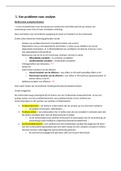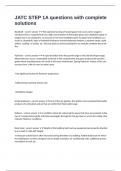European Integration: summary
LEARNING OBJECTIVES ZIE PPT
Politico.eu (for sources) Playbook subscription (+ Euractive)
Contents
1. Introduction............................................................................................................................9
1.1 ‘The three worlds of European Integration’.....................................................................9
1.2 Three ‘generations’/questions of EU studies of scholars.................................................9
1.3 Integration versus functioning of the EU........................................................................10
1.4 Learning objectives.........................................................................................................10
2. Theories of European Integration.........................................................................................13
2.1 ‘The three worlds of European Integration’...................................................................13
2.2 Three ‘generations’ of EU studies...................................................................................13
2.3 Integration versus functioning of the EU........................................................................13
2.4 The Intellectual Background...........................................................................................13
2.4.1 Academic (fathers of European Integration)...........................................................13
2.4.2 Political.....................................................................................................................14
2.4.3 Political / bureaucratic.............................................................................................14
2.5 IR Theories of European Integration...............................................................................15
2.5.1 Neofunctionalism (Ernst Haas - 1958, Leon Lindberg – 1963/1968).......................15
2.5.2 Intergovernmentalism (Stanley Hoffmann – 1964/1968).......................................16
2.5.3 Liberal Intergovernmentalism (Andrew Moravcsik – 1993)....................................16
2.5.4 Supranational Governance (Sandholtz / Stone Sweet - 1998)................................17
2.5.5 New Intergovernmentalism (Bickerton, Hodson, Puetter 2015).............................17
2.5.6 Post-functionalism (Hooghe and Marks 2009)........................................................17
3. History of European Integration...........................................................................................18
3.1 1945-1957: first steps towards integration....................................................................18
3.1.1 Federalists (synonym for supranational) vs. intergovernmentalists.......................18
3.1.2 US Involvement........................................................................................................20
3.1.3 France and Jean Monnet..........................................................................................20
3.1.4 The Schuman Declaration and the ECSC..................................................................20
3.1.5 Failed attempt to establish a European Defense Community.................................21
3.1.6 Foundation of EEC and EURATOM...........................................................................21
3.2 1958-1969: De Gaulle dominates European politics......................................................22
3.2.1 De Gaulle’s European policy....................................................................................22
1
, 3.2.2 Evolution of the EEC.................................................................................................23
3.2.3 The ‘Empty Chair’ crisis............................................................................................23
3.2.4 The ‘Luxembourg Compromise’...............................................................................24
3.2.5 The UK’s membership application...........................................................................24
3.3 1969-1979: from Euro-optimism to Euro-pessimism.....................................................25
3.3.1 New ‘relance’ in The Hague.....................................................................................25
3.3.2 Results of ‘The Hague’..............................................................................................25
3.3.3 First enlargement.....................................................................................................25
3.3.4 Economic and political crisis....................................................................................26
3.3.5 British re-negotiations’.............................................................................................26
3.3.6 French - German axis...............................................................................................26
3.4 1979 – 1984: slow ‘relance’............................................................................................27
3.4.1 Second enlargement and first direct EP election.....................................................27
3.4.2 The European Monetary System (EMS)...................................................................27
3.4.3 Thatcher and the British contribution to the EU.....................................................28
3.4.4 ‘Relance’ in economic integration...........................................................................28
3.4.5 ‘Relance’ in political integration..............................................................................29
3.5 1985-1988: towards the single market...........................................................................29
3.5.1 Third enlargement...................................................................................................29
3.5.2 Designing the single market.....................................................................................30
3.5.3 Milano Summit and the IGC (1985 - 1986)..............................................................30
3.5.4 The European Single Act..........................................................................................30
3.5.5 Completion of the single market.............................................................................31
3.6 1989 – 1992 from Community to Union.........................................................................32
3.6.1 Changed circumstances...........................................................................................32
3.6.2 Two parallel IGCs......................................................................................................32
3.6.3 The EMU and EPU IGCs............................................................................................32
3.6.4 The Maastricht Treaty..............................................................................................33
3.6.5 The ratification of the Maastricht Treaty.................................................................34
3.7 1990 – 2000: developing the Union................................................................................34
3.7.1 The European Economic Area (EEA)........................................................................34
3.7.2 The fourth enlargement...........................................................................................35
3.7.3 Ratification and consequences of the enlargement................................................35
3.7.4 Preparations for a new IGC......................................................................................36
3.7.5 IGC negotiations.......................................................................................................36
2
, 3.7.6 The Treaty of Amsterdam........................................................................................36
3.7.7 The Treaty of Nice....................................................................................................38
3.8 From Nice to Lisbon........................................................................................................41
3.8.1 Overview of recent EU institutional reform:...........................................................41
3.9 Laeken European Council (December 2001)...................................................................41
3.10 The European Convention 2002-2003: composition....................................................42
3.11 Convention Draft Constitutional Treaty: radical reforms.............................................42
3.12 IGC and Constitutional Treaty.......................................................................................43
3.12.1 Constitutional Treaty - ratifications.......................................................................43
3.13 From Constitutional Treaty to Treaty of Lisbon............................................................44
3.14 The Treaty of Lisbon......................................................................................................44
3.14.1 Differences compared to the Draft Constitutional Treaty.....................................44
3.14.2 Main innovations...................................................................................................45
3.14.3 The new institutional system.................................................................................46
3.14.4 The High Representative for Foreign Affairs and Security Policy..........................46
3.14.5 National parliaments’ yellow and orange cards....................................................46
3.14.6 Main innovations...................................................................................................46
3.14.7 Ratification.............................................................................................................47
3.15 Latest developments 2009-2023..................................................................................47
4. EU enlargement....................................................................................................................49
4.1 Overview enlargement....................................................................................................49
4.2 The fifth/sixth Enlargement Process...............................................................................50
4.3 Enlargement: The Acquis Communaitaire......................................................................50
4.4 The fifth/sixth Enlargement Process...............................................................................51
4.5 Roadmap of the ‘Copenhagen 10’..................................................................................51
4.5.1 Bulgaria....................................................................................................................51
4.5.2 Romania...................................................................................................................52
4.6 Seventh Enlargement: Croatia........................................................................................52
4.7 Current applicants: Turkey..............................................................................................52
4.7.1 Turkey.......................................................................................................................53
4.7.2 Iceland......................................................................................................................54
4.7.3 Western Balkan........................................................................................................54
4.8 Non-enlargement............................................................................................................55
4.9 Enlargement: who’s next and what are the stakes?.......................................................55
4.10 European Neighbourhood Policy..................................................................................55
3
, 4.11 How can the EU shrink..................................................................................................57
4.11.1 Brexit arguments....................................................................................................57
5. EU Institutional Architecture.................................................................................................61
5.1 The EU as a Multi-level Governance System..................................................................61
5.2 European institutions......................................................................................................61
5.3 Interest groups................................................................................................................63
5.4 Clustering of policy domains...........................................................................................64
5.5 Policy domains................................................................................................................64
5.5.1 Definitions................................................................................................................64
5.5.2 Redistributive policies..............................................................................................64
5.5.3 Regulatory policies...................................................................................................65
5.5.4 Internal security policies..........................................................................................65
5.5.5 External policies.......................................................................................................65
5.5.6 Macro-economic policies.........................................................................................65
5.5.7 Types of EU Competences.......................................................................................66
5.5.8 Decision-making.......................................................................................................66
5.5.9 Policy modes............................................................................................................67
5.5.10 Supranational / legislative output.........................................................................68
5.5.11 Intergovernmental output.....................................................................................69
5.5.12 Mixed output.........................................................................................................69
5.6 The European Commission.............................................................................................69
5.6.1 Composition.............................................................................................................69
5.6.2 Agencies...................................................................................................................70
5.6.3 Policy-making and decision-making.........................................................................70
5.6.4 Implementation.......................................................................................................71
5.7 The European Parliament...............................................................................................71
5.7.1 Composition.............................................................................................................71
5.7.2 Competencies...........................................................................................................73
5.7.3 Control task..............................................................................................................73
5.8 The Council of Ministers (Council of the European Union)............................................73
5.8.1 Composition.............................................................................................................73
5.8.2 Formations...............................................................................................................74
5.8.3 Tasks and decision-making......................................................................................75
5.8.4 QMV before November 2014..................................................................................75
5.8.5 Voting as from 2014.................................................................................................75
4
LEARNING OBJECTIVES ZIE PPT
Politico.eu (for sources) Playbook subscription (+ Euractive)
Contents
1. Introduction............................................................................................................................9
1.1 ‘The three worlds of European Integration’.....................................................................9
1.2 Three ‘generations’/questions of EU studies of scholars.................................................9
1.3 Integration versus functioning of the EU........................................................................10
1.4 Learning objectives.........................................................................................................10
2. Theories of European Integration.........................................................................................13
2.1 ‘The three worlds of European Integration’...................................................................13
2.2 Three ‘generations’ of EU studies...................................................................................13
2.3 Integration versus functioning of the EU........................................................................13
2.4 The Intellectual Background...........................................................................................13
2.4.1 Academic (fathers of European Integration)...........................................................13
2.4.2 Political.....................................................................................................................14
2.4.3 Political / bureaucratic.............................................................................................14
2.5 IR Theories of European Integration...............................................................................15
2.5.1 Neofunctionalism (Ernst Haas - 1958, Leon Lindberg – 1963/1968).......................15
2.5.2 Intergovernmentalism (Stanley Hoffmann – 1964/1968).......................................16
2.5.3 Liberal Intergovernmentalism (Andrew Moravcsik – 1993)....................................16
2.5.4 Supranational Governance (Sandholtz / Stone Sweet - 1998)................................17
2.5.5 New Intergovernmentalism (Bickerton, Hodson, Puetter 2015).............................17
2.5.6 Post-functionalism (Hooghe and Marks 2009)........................................................17
3. History of European Integration...........................................................................................18
3.1 1945-1957: first steps towards integration....................................................................18
3.1.1 Federalists (synonym for supranational) vs. intergovernmentalists.......................18
3.1.2 US Involvement........................................................................................................20
3.1.3 France and Jean Monnet..........................................................................................20
3.1.4 The Schuman Declaration and the ECSC..................................................................20
3.1.5 Failed attempt to establish a European Defense Community.................................21
3.1.6 Foundation of EEC and EURATOM...........................................................................21
3.2 1958-1969: De Gaulle dominates European politics......................................................22
3.2.1 De Gaulle’s European policy....................................................................................22
1
, 3.2.2 Evolution of the EEC.................................................................................................23
3.2.3 The ‘Empty Chair’ crisis............................................................................................23
3.2.4 The ‘Luxembourg Compromise’...............................................................................24
3.2.5 The UK’s membership application...........................................................................24
3.3 1969-1979: from Euro-optimism to Euro-pessimism.....................................................25
3.3.1 New ‘relance’ in The Hague.....................................................................................25
3.3.2 Results of ‘The Hague’..............................................................................................25
3.3.3 First enlargement.....................................................................................................25
3.3.4 Economic and political crisis....................................................................................26
3.3.5 British re-negotiations’.............................................................................................26
3.3.6 French - German axis...............................................................................................26
3.4 1979 – 1984: slow ‘relance’............................................................................................27
3.4.1 Second enlargement and first direct EP election.....................................................27
3.4.2 The European Monetary System (EMS)...................................................................27
3.4.3 Thatcher and the British contribution to the EU.....................................................28
3.4.4 ‘Relance’ in economic integration...........................................................................28
3.4.5 ‘Relance’ in political integration..............................................................................29
3.5 1985-1988: towards the single market...........................................................................29
3.5.1 Third enlargement...................................................................................................29
3.5.2 Designing the single market.....................................................................................30
3.5.3 Milano Summit and the IGC (1985 - 1986)..............................................................30
3.5.4 The European Single Act..........................................................................................30
3.5.5 Completion of the single market.............................................................................31
3.6 1989 – 1992 from Community to Union.........................................................................32
3.6.1 Changed circumstances...........................................................................................32
3.6.2 Two parallel IGCs......................................................................................................32
3.6.3 The EMU and EPU IGCs............................................................................................32
3.6.4 The Maastricht Treaty..............................................................................................33
3.6.5 The ratification of the Maastricht Treaty.................................................................34
3.7 1990 – 2000: developing the Union................................................................................34
3.7.1 The European Economic Area (EEA)........................................................................34
3.7.2 The fourth enlargement...........................................................................................35
3.7.3 Ratification and consequences of the enlargement................................................35
3.7.4 Preparations for a new IGC......................................................................................36
3.7.5 IGC negotiations.......................................................................................................36
2
, 3.7.6 The Treaty of Amsterdam........................................................................................36
3.7.7 The Treaty of Nice....................................................................................................38
3.8 From Nice to Lisbon........................................................................................................41
3.8.1 Overview of recent EU institutional reform:...........................................................41
3.9 Laeken European Council (December 2001)...................................................................41
3.10 The European Convention 2002-2003: composition....................................................42
3.11 Convention Draft Constitutional Treaty: radical reforms.............................................42
3.12 IGC and Constitutional Treaty.......................................................................................43
3.12.1 Constitutional Treaty - ratifications.......................................................................43
3.13 From Constitutional Treaty to Treaty of Lisbon............................................................44
3.14 The Treaty of Lisbon......................................................................................................44
3.14.1 Differences compared to the Draft Constitutional Treaty.....................................44
3.14.2 Main innovations...................................................................................................45
3.14.3 The new institutional system.................................................................................46
3.14.4 The High Representative for Foreign Affairs and Security Policy..........................46
3.14.5 National parliaments’ yellow and orange cards....................................................46
3.14.6 Main innovations...................................................................................................46
3.14.7 Ratification.............................................................................................................47
3.15 Latest developments 2009-2023..................................................................................47
4. EU enlargement....................................................................................................................49
4.1 Overview enlargement....................................................................................................49
4.2 The fifth/sixth Enlargement Process...............................................................................50
4.3 Enlargement: The Acquis Communaitaire......................................................................50
4.4 The fifth/sixth Enlargement Process...............................................................................51
4.5 Roadmap of the ‘Copenhagen 10’..................................................................................51
4.5.1 Bulgaria....................................................................................................................51
4.5.2 Romania...................................................................................................................52
4.6 Seventh Enlargement: Croatia........................................................................................52
4.7 Current applicants: Turkey..............................................................................................52
4.7.1 Turkey.......................................................................................................................53
4.7.2 Iceland......................................................................................................................54
4.7.3 Western Balkan........................................................................................................54
4.8 Non-enlargement............................................................................................................55
4.9 Enlargement: who’s next and what are the stakes?.......................................................55
4.10 European Neighbourhood Policy..................................................................................55
3
, 4.11 How can the EU shrink..................................................................................................57
4.11.1 Brexit arguments....................................................................................................57
5. EU Institutional Architecture.................................................................................................61
5.1 The EU as a Multi-level Governance System..................................................................61
5.2 European institutions......................................................................................................61
5.3 Interest groups................................................................................................................63
5.4 Clustering of policy domains...........................................................................................64
5.5 Policy domains................................................................................................................64
5.5.1 Definitions................................................................................................................64
5.5.2 Redistributive policies..............................................................................................64
5.5.3 Regulatory policies...................................................................................................65
5.5.4 Internal security policies..........................................................................................65
5.5.5 External policies.......................................................................................................65
5.5.6 Macro-economic policies.........................................................................................65
5.5.7 Types of EU Competences.......................................................................................66
5.5.8 Decision-making.......................................................................................................66
5.5.9 Policy modes............................................................................................................67
5.5.10 Supranational / legislative output.........................................................................68
5.5.11 Intergovernmental output.....................................................................................69
5.5.12 Mixed output.........................................................................................................69
5.6 The European Commission.............................................................................................69
5.6.1 Composition.............................................................................................................69
5.6.2 Agencies...................................................................................................................70
5.6.3 Policy-making and decision-making.........................................................................70
5.6.4 Implementation.......................................................................................................71
5.7 The European Parliament...............................................................................................71
5.7.1 Composition.............................................................................................................71
5.7.2 Competencies...........................................................................................................73
5.7.3 Control task..............................................................................................................73
5.8 The Council of Ministers (Council of the European Union)............................................73
5.8.1 Composition.............................................................................................................73
5.8.2 Formations...............................................................................................................74
5.8.3 Tasks and decision-making......................................................................................75
5.8.4 QMV before November 2014..................................................................................75
5.8.5 Voting as from 2014.................................................................................................75
4











